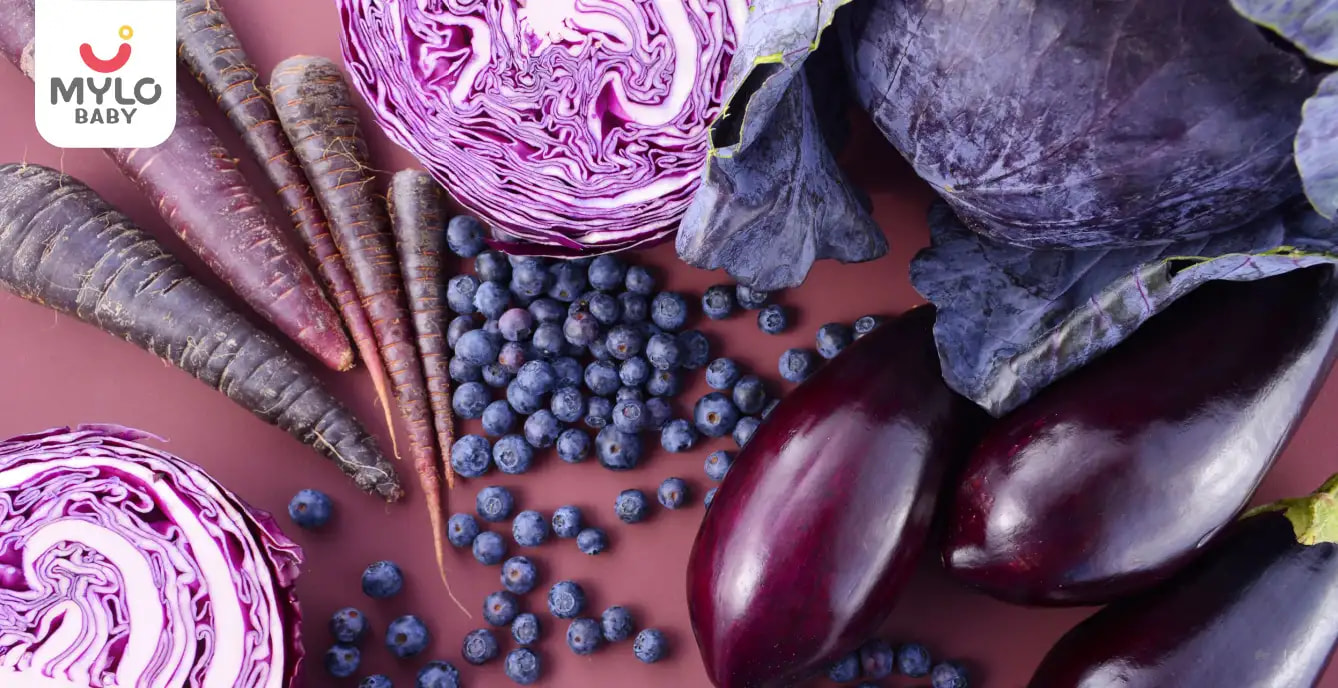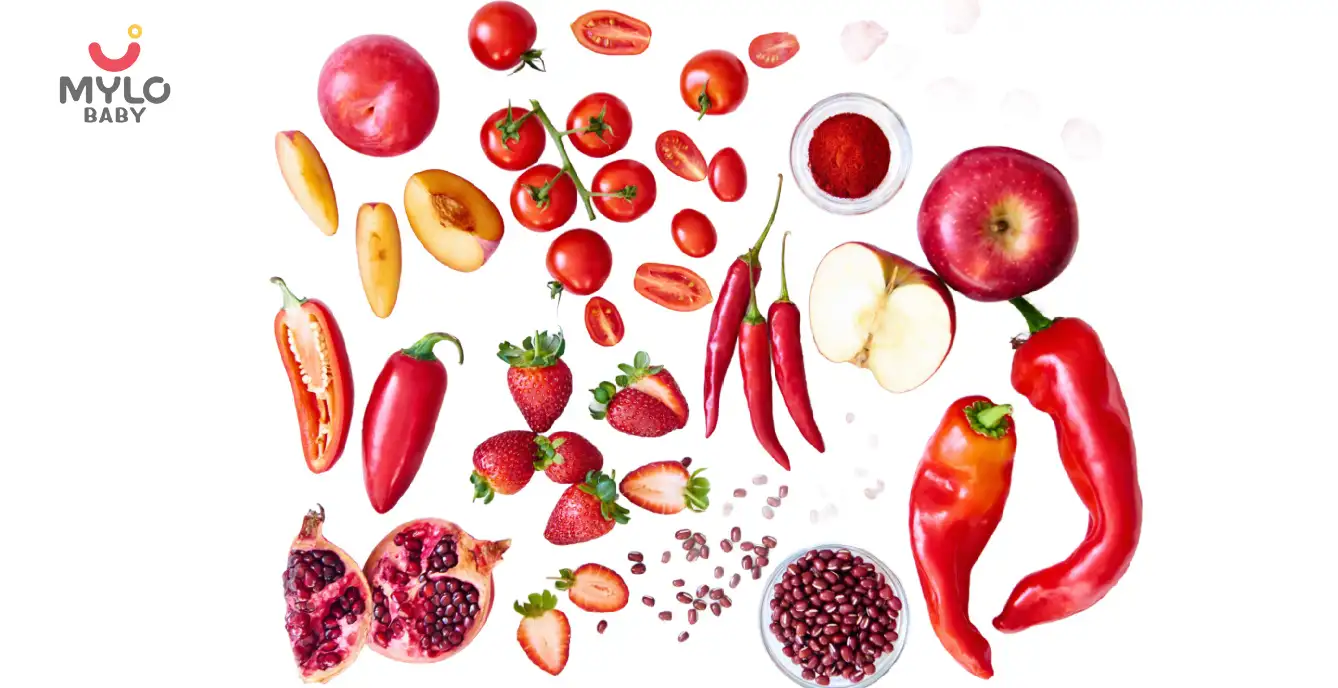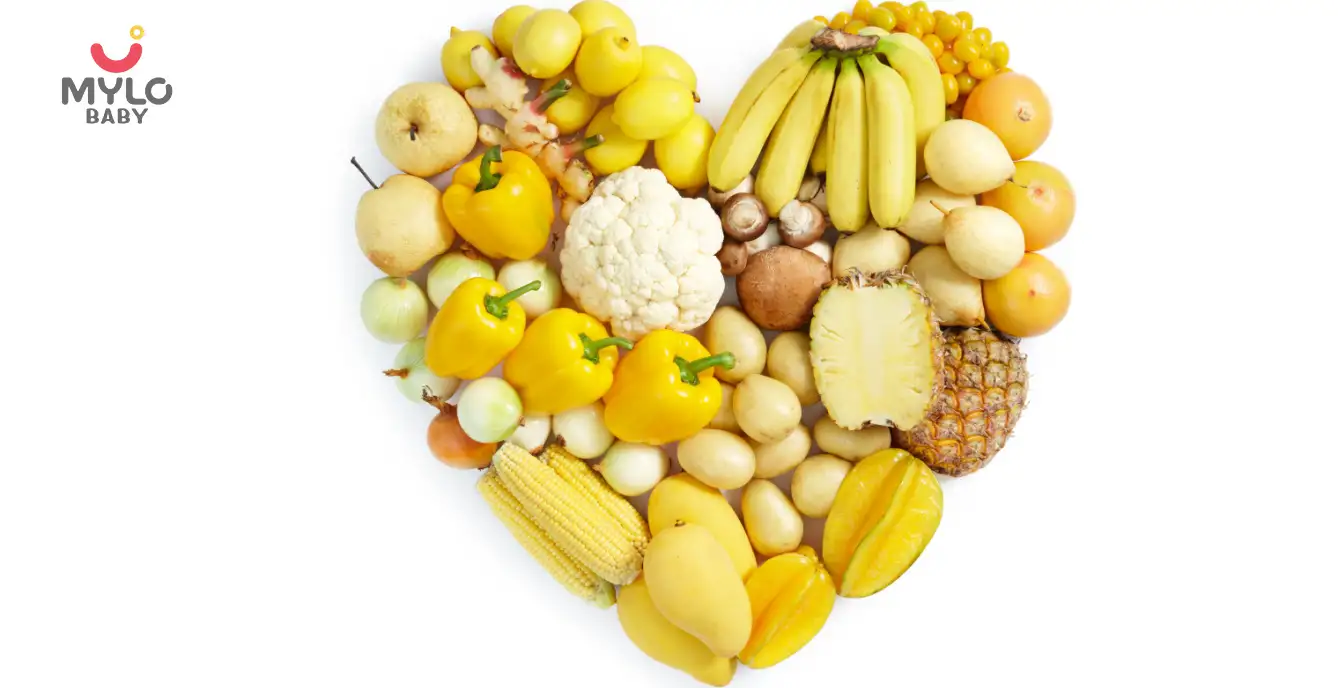Home

The A-Z Guide on Purple Colour Fruits and Vegetables for Kids
In this Article

Baby Care
The A-Z Guide on Purple Colour Fruits and Vegetables for Kids
Updated on 2 February 2024
Introducing children to the fascinating world of fruits and vegetables is an exciting journey, and what better way to capture their imagination than by exploring the vibrant world of purple produce! From the alluring shades of eggplant to the rich hues of grapes, the realm of purple fruits and vegetables offers a delightful array of flavors, textures, and nutrients waiting to be discovered.
So, whether you call them blue fruits and vegetables or purple, we will explore all about them and list their names as well in this informative article.
What are purple or blue fruits?
Blue and purple colour fruits are not only visually appealing but also packed with nutrients that are beneficial for kids. These fruits get their vibrant hues from natural pigments called anthocyanins, which have been shown to have antioxidant and anti-inflammatory properties.
These fruits are not only delicious but also offer a range of health benefits. Blueberries, for instance, are known for their high antioxidant content, which can help protect against oxidative stress and promote brain health. Blackberries are rich in fiber, vitamin C, and vitamin K, which are essential for maintaining a healthy immune system and promoting bone health.
What are purple vegetables?
Purple colour vegetables are a great addition to a child's diet as they not only add color to their plate but also offer a range of health benefits. These vegetables get their purple hue from natural pigments called anthocyanins, which have been shown to have antioxidant and anti-inflammatory properties.
Purple sweet potatoes are not only visually appealing but also packed with nutrients. They are a good source of fiber, vitamin C, and potassium, which are essential for healthy digestion and immune function. Purple cabbage is another nutritious vegetable that is rich in antioxidants and can help support heart health. Eggplant is a versatile vegetable that can be prepared in a variety of ways, and it is a good source of fiber, potassium, and vitamin K.
You may also like: The A-Z Guide on Red Colour Fruits & Red Colour Vegetables for Kids
Blue or Purple Colour Fruits and Vegetables
Blue and purple fruits and vegetables not only add a pop of color to meals but also provide essential nutrients. Here are some fun and nutritious options to consider:
Blue or purple vegetable names
Here are some of the most commonly found purple colour vegetables in India:
1. Eggplant
Also known as Brinjal, eggplant is a popular vegetable in Indian cuisine. It comes in a variety of shapes, sizes, and colors, with the most common being the large, deep purple variety.
2. Purple potatoes
Most commonly available in golden/yellow colour, there are some varieties of potatoes like the Purple Majesty or Violet Queen that are purple in colour.
3. Purple carrots
Also known as Kali Gajar, purple carrots are rich in antioxidants and the powerhouse of vitamin K and other minerals.
4. Purple Beans
Purple beans, also known as purple string beans or purple snap beans, are a unique variety of beans that are characterized by their vibrant purple color.
5. Blue Peas
Blue peas, also known as butterfly peas, are a type of flowering plant characterized by its striking blue flowers. It can be used as a natural food colour and in herbal tea, cocktails and mocktails.
6. Purple lettuce
Purple lettuce comes in various loose-leaf varieties with broad curly leaves. It contains an abundance of anthocyanins, an important antioxidant.
Purple or blue fruit names
Here are some of the most common blue or purple fruit name:
1. Jamun (Black Plum)
Jamun is a deep purple fruit with a tangy-sweet flavor. It is rich in antioxidants and is known to have various health benefits, including aiding in digestion and managing diabetes.
2. Blueberries
Blueberries are small, round, and deep blue in color, known for their sweet and slightly tangy taste.
3. Black grapes
Black grapes are a common and popular fruit in India. They are rich in vitamins and antioxidants and are used to make juices, jams, and consumed as a fresh fruit.
4. Plums
Plums have a deep purple skin and flesh. They are sweet and juicy, often eaten fresh or used in jams and preserves.
5. Passion fruit
Passion fruit has a tough outer rind and a juicy, seed-filled interior. Some varieties have purple-colored skin when ripe.
6. Mulberries
Mulberries come in various colors, including deep purple. They have a sweet flavor and are enjoyed fresh or used in jams and desserts.
7. Elderberry
Elderberries are used in traditional medicine, and their dark purple to black color is indicative of their rich anthocyanin content.
You may also like: The A-Z Guide on Yellow Fruits & Yellow Colour Vegetables for Kids
Tips to make learning purple fruits and vegetables easy for kids
Learning about purple or blue colour fruits and vegetables can be an exciting and educational experience for kids. Here are seven tips to make the process fun and engaging:
1. Create a colorful display
Set up a colorful display of purple colour fruits and vegetables in the kitchen or dining area. This visual representation can spark curiosity and make learning about these foods more interesting for kids.
2. Go on a scavenger hunt
Create a scavenger hunt where kids have to find and identify different blue fruits and vegetables in the grocery store or farmer's market. This can make the learning process interactive and engaging.
3. Cook together
Involve kids in the cooking process by letting them help prepare dishes that feature purple colour vegetables and purple fruits. This hands-on experience can make them more excited about trying these foods.
4. Try new recipes
Explore different recipes that incorporate blue fruits and blue vegetables. Whether it's a smoothie, a roasted vegetable medley, or a fruit salad, trying new recipes can expose kids to a variety of flavors and textures.
5. Make it a game
Turn learning about blue colour vegetables and fruits into a game by playing "Guess the Fruit or Vegetable." Blindfold kids and let them taste different purple foods while trying to guess what they are.
6. Grow your own
Consider starting a small garden where kids can grow their own purple fruits and purple vegetables. This hands-on experience can teach them about the process of food production and make them more enthusiastic about eating what they have grown.
7. Make it a regular part of meals
Incorporate purple colour fruits and vegetables into meals on a regular basis. By making them a consistent part of the menu, kids will become more familiar with these foods and more likely to develop a taste for them.
Key takeaways
Introducing kids to the world of purple colour fruits and vegetables can be an exciting and educational experience. Purple or blue fruits like blueberries and grapes, as well as purple vegetables like eggplant and purple sweet potatoes, offer a range of health benefits for children. By involving kids in the process and making it enjoyable, they are more likely to develop a positive relationship with purple fruits and vegetables and embrace a healthy eating lifestyle.



Written by
Anupama Chadha
Anupama Chadha, born and raised in Delhi is a content writer who has written extensively for industries such as HR, Healthcare, Finance, Retail and Tech.
Read MoreGet baby's diet chart, and growth tips

Related Articles
Related Questions
Hello frnds..still no pain...doctor said head fix nhi hua hai..bt vagina me pain hai aur back pain bhi... anyone having same issues??

Kon kon c chije aisi hai jo pregnancy mei gas acidity jalan karti hain... Koi btayega plz bcz mujhe aksar khane ke baad hi samagh aata hai ki is chij se gas acidity jalan ho gyi hai. Please share your knowledge

I am 13 week pregnancy. Anyone having Storione-xt tablet. It better to have morning or night ???

Hlo to be moms....i hv a query...in my 9.5 wk i feel body joint pain like in ankle, knee, wrist, shoulder, toes....pain intensity is high...i cnt sleep....what should i do pls help....cn i cosult my doc.

Influenza and boostrix injection kisiko laga hai kya 8 month pregnancy me and q lagta hai ye plz reply me

Related Topics
RECENTLY PUBLISHED ARTICLES
our most recent articles

Education
The A-Z Guide on Red Colour Fruits & Red Colour Vegetables for Kids

Education
The A-Z Guide on Yellow Fruits & Yellow Colour Vegetables for Kids

Women Specific Issues
Cervical Cancer: Causes, Symptoms & Prevention

Education
The A-Z Guide to Identifying Stem Vegetables for Kids

Fetal Heartbeat
Can Fetal Heartbeat Disappear and Reappear?

Education
The Ultimate Guide to Teaching Children 20 to 30 Tables
- GK Questions for Kids from Nursery to Class 6
- Height and Weight Chart for Boys and Girls in India
- The A-Z Guide to Identifying Winter Vegetables for Kids
- Dalia in Pregnancy: A Superfood for the Health of Both Mom and Baby
- 1st Birthday Wishes for Your Little One's Big Day
- The Ultimate Guide to Consuming Litchi During Pregnancy
- Almonds in Pregnancy: Cracking the Nutty Secret to Their Benefits
- Popping the Question: Is It Safe to Indulge in Popcorn in Pregnancy?
- Cherry Fruit in Pregnancy: What Every Expectant Mother Should Know
- The Ultimate Guide to Consuming Pista During Pregnancy
- Sugarcane Juice in Pregnancy: Benefits & Precautions
- The Ultimate Guide to Consuming Mushroom in Pregnancy
- The Ultimate Compilation of GK Questions and Their Answers
- The Ultimate Compilation of 2 Letter Words for Children


AWARDS AND RECOGNITION

Mylo wins Forbes D2C Disruptor award

Mylo wins The Economic Times Promising Brands 2022
AS SEEN IN
















- Mylo Care: Effective and science-backed personal care and wellness solutions for a joyful you.
- Mylo Baby: Science-backed, gentle and effective personal care & hygiene range for your little one.
- Mylo Community: Trusted and empathetic community of 10mn+ parents and experts.
Product Categories
baby carrier | baby soap | baby wipes | stretch marks cream | baby cream | baby shampoo | baby massage oil | baby hair oil | stretch marks oil | baby body wash | baby powder | baby lotion | diaper rash cream | newborn diapers | teether | baby kajal | baby diapers | cloth diapers |








